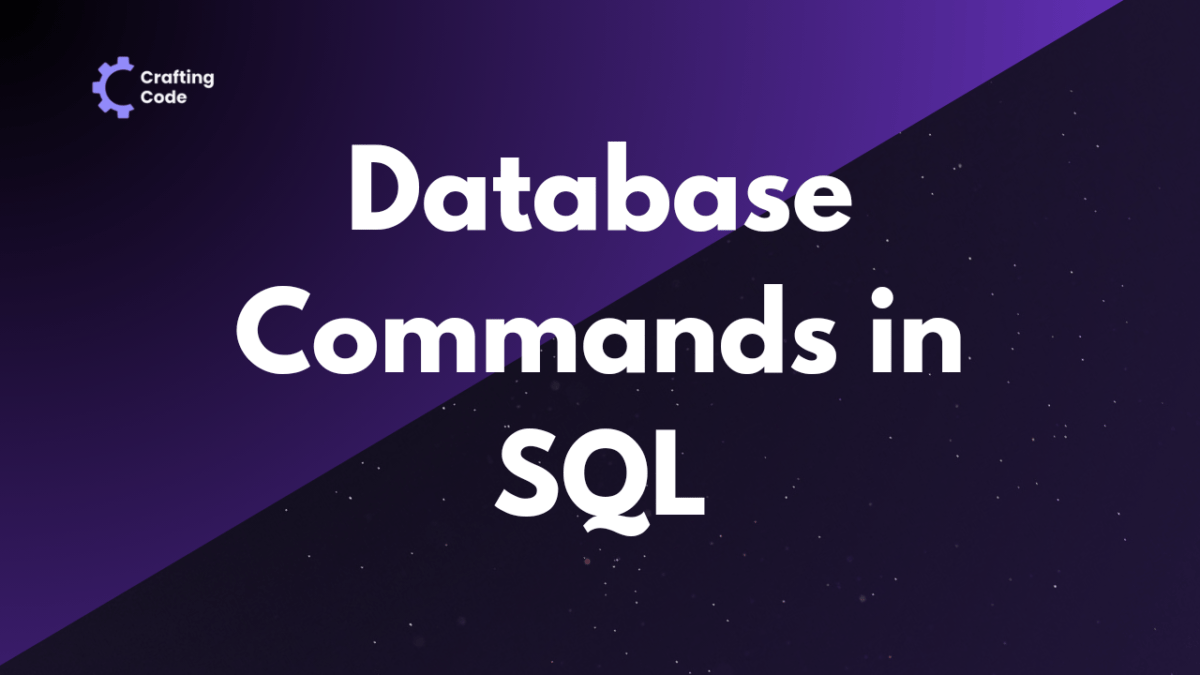In database management, the database commands serve as the backbone for interacting with and manipulating data. These commands are categorized into distinct types, each serving for specific purposes in the management and querying of databases. Understanding the various types of database commands is essential for database administrators, developers, and users alike.
This article we’ll get into Data Definition Language (DDL), Data Query Language (DQL), Data Manipulation Language (DML), Data Control Language (DCL), and Transaction Control Language (TCL) commands, shedding light on their functionalities and significance in database management.
- What are Database Commands?
- Comparison of DDL, DQL, DML, DCL, and TCL Commands
- Data Definition Language (DDL) Commands
- Data Query Language (DQL) Command
- Data Manipulation Language (DML) Commands
- Data Control Language (DCL) Commands
- Transaction Control Language (TCL) Commands
- Importance of Understanding Database Commands
What are Database Commands?
Database commands encompass a set of instructions used to interact with databases, facilitating various operations such as creation, retrieval, modification, and deletion of data. These commands are essential components of database management systems (DBMS) and play a important role in administering and manipulating databases effectively.
Role of Commands in Managing and Manipulating Databases
- Data Definition: Database commands, particularly those categorized under Data Definition Language (DDL), are utilized to define the structure of the database schema. This includes creating, altering, and dropping database objects such as tables, indexes, views, and procedures.
- Data Retrieval: Commands falling under Data Query Language (DQL), most notably the SELECT statement, are employed to retrieve specific data from the database based on predefined criteria. DQL commands enable users to query the database and extract relevant information for analysis or presentation.
- Data Manipulation: Data Manipulation Language (DML) commands enable users to modify, insert, update, and delete data stored within the database tables. These commands facilitate the manipulation of data to reflect changes in the application or business requirements.
- Access Control: Data Control Language (DCL) commands are instrumental in regulating user access and privileges within the database environment. DCL commands such as GRANT and REVOKE govern permissions related to data manipulation, ensuring security and integrity.
- Transaction Management: Transaction Control Language (TCL) commands are utilized to manage database transactions, which represent units of work performed within the database. TCL commands such as COMMIT, ROLLBACK, and SAVEPOINT facilitate transaction control, ensuring data consistency and reliability.
Comparison of DDL, DQL, DML, DCL, and TCL Commands
| Command Type | Description | Common Commands | Use Case |
| Data Definition Language (DDL) | Used for defining and modifying database structure | CREATE, ALTER, DROP, TRUNCATE, COMMENT, RENAME | Creating tables, altering table structures, dropping tables, etc. |
| Data Query Language (DQL) | Used for retrieving data from the database | SELECT | Retrieving specific data from database tables based on criteria |
| Data Manipulation Language (DML) | Used for manipulating data within the database | INSERT, UPDATE, DELETE, LOCK | Inserting new records, updating existing records, deleting records, managing locks |
| Data Control Language (DCL) | Used for controlling access and permissions to data | GRANT, REVOKE | Granting or revoking privileges to users or roles |
| Transaction Control Language (TCL) | Used for managing transactions within the database | COMMIT, ROLLBACK, SAVEPOINT | Committing changes, rolling back transactions, creating savepoints |
Let’s explore them One-by-one:
Data Definition Language (DDL) Commands
Data Definition Language (DDL) commands are an essential component of database management systems (DBMS) used to define the structure of the database schema. These commands enable users to create, modify, and manage database objects such as tables, indexes, views, and procedures. Below is an explanation of common DDL commands along with examples and use cases for each:
CREATE
The CREATE command is used to create new database objects such as tables, indexes, views, or procedures. It allows users to specify the name, structure, and other properties of the object being created.
Syntax:
CREATE TABLE table_name
(
column_1 datatype,
column_2 datatype,
column_3 datatype,
....
);Use Case: Creating a new table named “Employees” to store employee information with columns for EmployeeID, FirstName, LastName, and Department.
Example:
CREATE TABLE Employees (
EmployeeID INT PRIMARY KEY,
FirstName VARCHAR(50),
LastName VARCHAR(50),
Department VARCHAR(50)
);ALTER
The ALTER command is used to modify the structure of existing database objects. It allows users to add, modify, or drop columns, constraints, or other attributes of tables and other objects.
Syntax:
ALTER TABLE table_name
ADD column_name datatype;Use Case: Adding a new column named “Email” to the “Employees” table to store email addresses.
Example:
ALTER TABLE Employees
ADD COLUMN Email VARCHAR(100);DROP
The DROP command is used to delete or remove existing database objects such as tables, indexes, or views from the database schema. It permanently removes the specified object and its associated data from the database.
Syntax:
DROP TABLE table_name;Use Case: Dropping the “Employees” table from the database schema when it is no longer needed.
Example:
DROP TABLE Employees;TRUNCATE
The TRUNCATE command is used to remove all records from a table, but the table structure, indexes, and constraints remain intact.
Syntax:
TRUNCATE TABLE table_name;Use Case: Removing all employee records from the “Employees” table without deleting the table itself.
Example:
TRUNCATE TABLE Employees;
COMMENT
The COMMENT command is used to add comments or annotations to database objects such as tables, columns, or views, providing additional information about the object.
Syntax:
COMMENT ON COLUMN table_name.column_name IS 'comment_text';Use Case: Adding a comment to the “EmployeeID” column in the “Employees” table to describe its purpose.
Example:
COMMENT ON COLUMN Employees.EmployeeID IS 'Unique identifier for each employee';RENAME
The RENAME command is used to rename an existing database object such as a table, index, or column.
Syntax:
ALTER TABLE old_table_name RENAME TO new_table_name;Use Case: Renaming the “Employees” table to “Staff” to better reflect its purpose or naming convention.
Example:
ALTER TABLE Employees
RENAME TO Staff;
Data Query Language (DQL) Command
Data Query Language (DQL) commands are used to retrieve data from a database. The primary focus of DQL is the SELECT statement, which allows users to query database tables and retrieve specific information based on specified criteria.
DQL commands are designed to interact with the data stored within database tables. The SELECT statement, in particular, is a powerful tool for retrieving data from one or more tables. It allows users to specify which columns they want to retrieve, as well as any conditions or criteria that the data must meet.
SELECT
Retrieving data from database tables:
Using the SELECT statement, users can retrieve data from one or more tables in a database. They can specify the columns they want to retrieve, as well as any conditions that the data must meet. This allows for highly targeted queries that return only the data that is relevant to the user’s needs.
Examples demonstrating the usage of SELECT statement:
- Retrieve all columns from a specific table:
SELECT * FROM Employees;- Retrieve specific columns from a table:
SELECT FirstName, LastName FROM Employees;- Retrieve data based on a condition:
SELECT * FROM Employees WHERE Department = 'IT';- Retrieve data with sorted results:
SELECT * FROM Employees ORDER BY LastName ASC;- Retrieve aggregated data using GROUP BY:
SELECT Department, COUNT(*) AS EmployeeCount FROM Employees GROUP BY Department;- Retrieve data from multiple tables using JOIN:
SELECT Orders.OrderID, Customers.CustomerName
FROM Orders
INNER JOIN Customers ON Orders.CustomerID = Customers.CustomerID;These examples demonstrate the versatility of the SELECT statement in retrieving data from database tables.
Data Manipulation Language (DML) Commands
Data Manipulation Language (DML) commands are used to manipulate data stored within database tables. These commands are responsible for performing operations that affect the data stored within database tables. DML commands enable users to insert new data, update existing data, delete unwanted data, and manage locks on data to control concurrent access.
INSERT
The INSERT command is used to add new records into a table.
Syntax:
INSERT INTO table_name (column1, column2, ...)
VALUES (value1, value2, ...);Use Case: Adding a new employee record to the Employees table.
Example:
INSERT INTO Employees (FirstName, LastName, Department)
VALUES ('Crafting', 'Code', 'Development');UPDATE
The UPDATE command is used to modify existing records in a table.
Syntax:
UPDATE table_name
SET column1 = value1, column2 = value2, ...
WHERE condition;Use Case: Updating the salary of an employee with a specific ID.
Example:
UPDATE Employees
SET Salary = 55000
WHERE EmployeeID = 123;DELETE
The DELETE command is used to remove records from a table.
Syntax:
DELETE FROM table_name
WHERE condition;
Use Case: Removing inactive employees from the Employees table.
Example:
DELETE FROM Employees
WHERE IsActive = 'N';LOCK
The LOCK command is used to control concurrent access to data by locking rows in a table.
Syntax:
LOCK TABLE table_name IN lock_mode;Use Case: Preventing other users from modifying specific rows while performing updates.
Example:
LOCK TABLE Employees IN EXCLUSIVE MODE;DML commands are essential for manipulating data within database tables, allowing users to insert, update, delete, and manage locks on data to ensure data integrity and consistency.
Data Control Language (DCL) Commands
Data Control Language (DCL) commands are used to control access to database objects, such as tables, views, and procedures, by granting or revoking permissions to users and roles. These commands play a critical role in database security and ensure that only authorized users can perform specific actions on database objects.
DCL commands are designed to manage access and permissions to database objects, ensuring data security and integrity. These commands allow database administrators to grant or revoke privileges to users and roles, thereby controlling the actions that users can perform on database objects. By using DCL commands effectively, administrators can enforce security policies and prevent unauthorized access to sensitive data. Below is an explanation of DCL commands, along with common commands like GRANT and REVOKE, and how they manage access and permissions to database objects:
GRANT
The GRANT command is used to grant specific privileges to users or roles on database objects.
Syntax:
GRANT privileges ON object TO user;Use Case: Granting SELECT privilege on the Employees table to a user named ‘john’:
Example:
GRANT SELECT ON Employees TO john;REVOKE
The REVOKE command is used to revoke previously granted privileges from users or roles on database objects.
Syntax:
REVOKE privileges ON object FROM user;Use Case: Revoking INSERT privilege on the Employees table from a user named ‘smith’:
Example:
REVOKE INSERT ON Employees FROM smith;How DCL commands manage access and permissions to database objects
DCL commands manage access and permissions to database objects by granting or revoking privileges to users and roles. When privileges are granted to a user or role using the GRANT command, they are allowed to perform specific actions, such as SELECT, INSERT, UPDATE, or DELETE, on the specified database object. Conversely, when privileges are revoked using the REVOKE command, the user or role is no longer allowed to perform those actions on the object.
Transaction Control Language (TCL) Commands
Transaction Control Language (TCL) commands are used to manage transactions within a database. Transactions are sequences of database operations that are treated as a single unit of work, ensuring data integrity and consistency. TCL commands allow users to control the outcome of transactions by committing changes, rolling back to a previous state, or creating savepoints.
TCL commands are designed to manage transactions within a database, ensuring data consistency and integrity. These commands allow users to control the outcome of transactions by committing changes to make them permanent, rolling back changes to revert them, or creating savepoints to mark specific points within a transaction. By using TCL commands effectively, users can ensure that database operations are completed successfully and that data remains in a consistent state. Below is an explanation of TCL commands, along with common commands like COMMIT, ROLLBACK, and SAVEPOINT, along with examples and use cases for each:
COMMIT
The COMMIT command is used to permanently save the changes made during the current transaction.
Syntax:
COMMIT;Example: Committing the changes made during the current transaction
ROLLBACK
The ROLLBACK command is used to undo the changes made during the current transaction and revert to the previous state.
Syntax:
ROLLBACK;Example: Rolling back the changes made during the current transaction
SAVEPOINT
The SAVEPOINT command is used to set a named savepoint within the current transaction, allowing for partial rollback.
Syntax:
SAVEPOINT savepoint_name;Example: Creating a savepoint named ‘sp1’ within the current transaction:
Understanding transactions and their management using TCL commands:
Transactions are crucial for ensuring data integrity and consistency within a database. TCL commands provide users with the ability to control the outcome of transactions, allowing them to commit changes to make them permanent, rollback changes to revert them, or create savepoints to mark specific points within a transaction.
Importance of Understanding Database Commands
- Efficient Database Management: Strong grasp of database commands empowers users to efficiently manage databases, ensuring optimal performance and data integrity.
- Accurate Data Retrieval: Understanding query language commands facilitates precise data retrieval, enabling users to extract relevant information from databases with ease.
- Enhanced Security and Access Control: Proficiency in control language commands enables administrators to enforce security measures and regulate user access, safeguarding sensitive data.
- Transaction Management: Competence in transaction control commands allows for effective management of database transactions, ensuring data consistency and reliability.
- Compliance and Governance: Knowledge of database commands facilitates adherence to regulatory requirements and governance standards, fostering compliance and mitigating risks associated with data management.
We provide insightful content and resources to empower developers on their coding journey. If you found this content helpful, be sure to explore more of our materials for in-depth insights into various Programming Concepts.
Stay tuned for future articles and tutorials that illustrate complex topics, helping you become a more proficient and confident developer.



